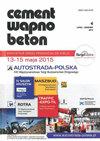汽车玻璃废料在环氧聚合物混凝土生产中的应用
IF 0.6
4区 工程技术
Q4 CONSTRUCTION & BUILDING TECHNOLOGY
引用次数: 0
摘要
本文以汽车风挡玻璃碎料为原料,用细石英砂作为环氧基聚合物混凝土的增强相,以不同的组分制备骨料,并对所得样品进行了测试。对所制备的复合材料进行了抗弯、抗压、抗夏比冲击试验。测定了孔隙率、吸水率和密度。试验结果表明,在聚合物混凝土中应用汽车挡风玻璃碎片,似乎是一种很好的废物回收方法。当玻璃含量为20%时,复合材料的抗压强度最高,为101 MPa。它比同时测试的传统混凝土的抗压强度(约15 MPa)提高了近7倍。最高的抗弯强度被注意到复合材料含有35 vol%的玻璃。聚合物混凝土样品的抗冲击性能不高,在5.85 ~ 10.13 kJ/m2之间。然而,它随着玻璃含量的增加而增加,当复合材料含有50%的玻璃体积时,它的值最高。高分子混凝土样品中,35%砂、35%磨砂玻璃和30%环氧树脂的混合性能最佳。传统混凝土的开孔率为15.9%,聚合物混凝土的开孔率低于0.38%。传统混凝土和聚合物混凝土在开孔率和吸水率上的巨大差异,使我们可以得出结论,后者将具有更高的抗冻性。试验结果清楚地表明,聚合物混凝土的力学性能明显优于传统混凝土。本文章由计算机程序翻译,如有差异,请以英文原文为准。
The application of automotive glass waste in the production of epoxy polymer concrete
In this paper, the production of aggregate from car windshield cullet and the use of this aggregate, in various compositions with fine quartz sand, as the reinforcing phase of the epoxy matrix polymer concrete were used and the obtained samples were tested. The bending and compressive strength, Charpy’s impact resistance tests were performed on the obtained composites. The porosity, water absorption, and density were also determined. The tests performed have shown that the application of car windshield cullet in polymer concrete, seems to be a good way to recycle this waste. The highest compressive strength, equal to 101 MPa, was obtained by composites containing 20 vol% of milled glass. It is nearly 7 times higher than the value of traditional concrete tested simultaneously, which has about 15 MPa. The highest flexural strength was noted for the composite containing 35 vol% of the glass. Polymer concrete samples did not show high impact resistance, which was in the range of 5.85 - 10.13 kJ/m2 . However, it increases with increasing glass content and the highest value was obtained for the composite containing 50% of the glass volume. Among the polymer concrete samples, the best properties were obtained for the mixture of 35% sand, 35% ground glass and 30% epoxy resin. Open porosity of traditional concrete is 15.9%, and for polymer concrete it was lower than 0.38%. The large difference in open porosity and water absorption for traditional concrete and polymer concrete, allow us to conclude that the latter will have higher frost resistance. The test results clearly show the significantly better mechanical properties of polymer concrete than of traditional concrete.
求助全文
通过发布文献求助,成功后即可免费获取论文全文。
去求助
来源期刊

Cement Wapno Beton
CONSTRUCTION & BUILDING TECHNOLOGY-MATERIALS SCIENCE, COMPOSITES
CiteScore
1.30
自引率
28.60%
发文量
0
审稿时长
>12 weeks
期刊介绍:
The Publisher of the scientific bimonthly of international circulation, entitled "Cement-Wapno-Beton" ["Cement-Lime-Concrete"], is the Fundacja Cement, Wapno, Beton [Foundation Cement, Lime, Concrete]. The periodical is dedicated to the issues concerning mineral setting materials and concrete. It is concerned with the publication of academic and research works from the field of chemistry and technology of building setting materials and concrete
 求助内容:
求助内容: 应助结果提醒方式:
应助结果提醒方式:


